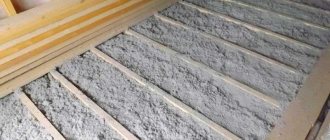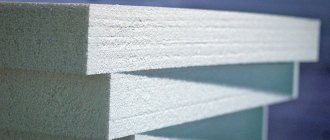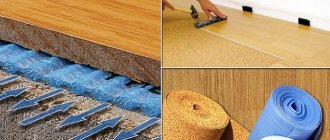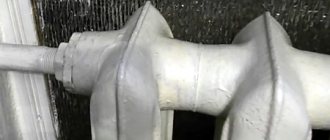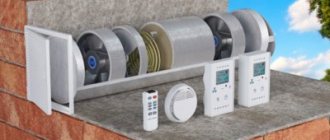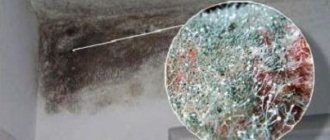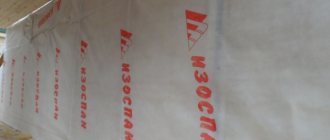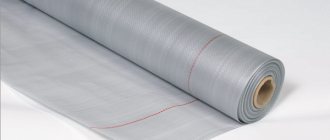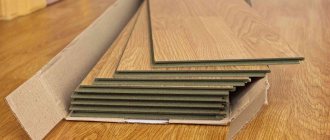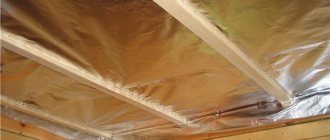Purpose of vapor barrier
After it became known that it is necessary to lay the insulation on the correct side, many people carrying out repairs have doubts. They begin to feel as if there is no need to protect their living space from steam condensation on the roof.
But vapor barrier is not a luxury, but a necessity. Water vapor is lighter than air, and therefore always rushes upward. If the room is unheated, there is no water vapor inside it, and there is really no need to protect it from it. But in Russia almost all houses are heated.
If the roof did not have protection against condensation and steam accumulation, the following problems would arise:
- The house would become much colder. You can compare a roof covered with moisture to a wet roof. Everyone knows that the drier the clothes, the better they retain heat. The same applies to houses;
- The roof, saturated with moisture, would gradually deteriorate. Over time, the waterproofing would also deteriorate;
- Mold and rot would appear on the roof. This is not surprising, because the bacteria that create them love water.
Roof covered with mold Source buzzbabble.ru
Vapor barrier in a cold climate and a room heated for six months is simply necessary.
Otherwise, over time, the roof will begin to leak, and mold will spread across its surface.
Steam or hydro?
Vapor barrier and waterproofing are two groups of different films. Each group has its own varieties, which today are marked with letter designations.
- Waterproofing is films and membranes that are installed outside the thermal insulation, that is, outside the room. They protect the insulation from external moisture, that is, from precipitation. They are usually vapor permeable, so they also remove condensation from the insulation.
- Vapor barriers are films and membranes that are installed on the inside of the room, as if before thermal insulation. They protect the insulation from the penetration of water vapor from inside the house.
Now let’s figure out which side to lay the hydro- and vapor barrier.
Types of vapor barrier
One of the main features of the market system is the very large variability of goods offered on the market. At least this is true if the market has not been captured by a monopoly. The same applies to materials that provide vapor barrier.
There are a lot of offers, but they are divided into 3 main types. These are film, vapor barrier membrane and diffusion membrane.
The film is a concrete wall from the world of vapor barrier. It does not allow moisture to pass through it in any form, including in the form of steam. It doesn't cost much.
A vapor barrier membrane is a film that not only does not allow steam to pass through, but also reflects infrared radiation. Tolerates high temperatures very well. Usually suitable for a bath. Not recommended for a residential building.
A diffusion membrane is a barrier that only partially allows vapor to pass through. This is the most popular type of insulation. This is not surprising, because such a membrane does not trap steam, but helps it quickly evaporate.
Diffusion membrane Source krovlya-perm.ru
The sides differ from each other only in the case of a diffusion membrane. In the case of other types of insulation, it does not matter which side to install them on.
What to glue mineral wool with foil to
Mineral wool with foil is produced in rolls and sheets. It is attached with universal construction adhesive.
Mineral wool with one-sided and double-sided foil is produced in rolls and sheets of different thicknesses. Mineral wool refers to all its varieties: from glass wool to basalt wool. It, like polystyrene foam, is glued to the wall and is additionally reinforced with dowels. What to glue insulation with mineral wool foil to? For work, use a universal plaster-adhesive mixture, which is suitable for both cotton wool and expanded polystyrene.
When choosing what to glue foil insulation with, you need to consider only high-quality mixtures from leading manufacturers:
- Knauf;
- Ceresit;
- Weber vetonit;
- Eunice.
If the surface on which the insulation is heated is flat, then apply the adhesive in a 3 cm layer with a notched trowel along the entire perimeter of the thermal insulation sheets. If the cotton wool is glued to an uneven surface, then the glue is applied with a thickness of 4 cm in cakes, the diameter of which is at least 10 cm.
In addition, before laying insulation with foil, you need to clean and prime the working surface for better adhesion. Again, we remind you about the ventilation gap and that the reflective foil should face the inside of the room. This material is not used for external insulation, as it is impractical. Mineral wool with foil is suitable for baths, as it is resistant to high temperatures, but it is afraid of moisture, so it must be protected with a vapor barrier. This does not apply to stone wool, since it practically does not absorb moisture.
The difference between the outside and the inside
In most cases, the easiest way to determine the side is to look at the instructions. There they usually write which side to put the material on. However, the opposite also happens. In this case, this can be determined by the appearance of the film. To determine the external and internal sides, you need to do the following:
- Look at the coloring . When colors differ, the lighter side is the inner side. Dark, respectively – external;
- The manufacturer's company logo is always on the outside. This helps the manufacturer in advertising their products;
- If foil is applied to the material , it must be on the outside;
- Run your hand along both sides . One of them will be fleecy - it is made this way in order to retain as much moisture as possible. This is the outside.
Let's summarize: to find out which side to lay the vapor barrier on, you need to look at the color of the membrane and the level of hairiness of the sides.
Diffusion membrane with fleecy and smooth sides Source teremspb.ru
See also: Catalog of companies that specialize in roof repairs
The difference between vapor barrier and waterproofing
Currently, thanks to commodity-market relations, you can find such a large number of materials that sometimes even professionals in their field cannot distinguish the film that retains steam from the one that is responsible for waterproofing. And during renovation or construction, this is important to know - before installing the film, you need to make sure that this installation does not cost the house sideways.
The main essence of vapor barrier is to prevent the penetration of moisture in any form, including in a liquid state. This means that any material that insulates a room from steam also protects it from water.
The original purpose of diffusion membranes is waterproofing. They allow steam to pass through, but help most of it to quickly evaporate. Although they are usually classified as vapor barriers, in reality they are not.
Scheme of vapor barrier operation Source opotolkax.com
It is diffusion membranes that can cause problems if they are installed on the wrong side. They only allow steam to pass in one direction, and therefore, if installed incorrectly, it will simply accumulate on the coating and cause even more problems than usual. That is why it is important to know which side to lay the vapor barrier film towards the insulation.
The specific problems caused by installing films in the wrong direction are not only that they will perform extremely poorly. They also consist in the fact that in this case steam will gradually, step by step, settle on the material. In winter, this will most likely lead to frost formation.
In some cases, even ice may form. And if this did happen, the film would be in trouble. It will deteriorate very quickly. And it will stop working completely and irrevocably.
Roof vapor barrier fasteners
Roof installation deserves special mention. Steam protection is especially important for a roof, and it is when installing insulation on it that the most problems arise. If the film is installed incorrectly in winter, the material can suffer greatly: steam can turn into frost.
To understand how to properly install a vapor barrier for a roof, you first need to study the physics of steam. Being lighter than air, it always rises and never falls. Therefore, thin wooden slats need to be attached on top of the film every 0.5 meters. Then there will be a small gap between the vapor barrier and the interior finishing of the roof.
The following are the main mistakes made when insulating a roof from steam:
- The seams are sealed with tape that is too thin. Its width must be at least 50 mm;
- The film is wrapped around the rafter beams. This is unacceptable, and insulation should only go on top of them;
- Do not leave a reserve of film during installation. This is vitally important - with changes in temperature and humidity, the material can become deformed;
- They do not seal the junction of the film to the ceiling. This is vitally important to do, otherwise sooner or later the material will simply peel off.
Vapor barrier of walls in wooden houses
Structures made of wooden materials require special vapor protection. Wooden houses are characterized by high vapor permeability of walls in comparison with brick and stone walls. This indicator is determined by the thickness of the timber and logs, the presence of cracks, and the impermeability of the grooves to moisture and steam.
Glued laminated timber, which is used to build walls, must be dried in production to an acceptable humidity level . It should also have sealing grooves and low shrinkage. All this is necessary to limit the flow of steam into the insulation.
Timber or log walls with natural moisture levels are dried directly during use. Due to shrinkage within 5 years, deformations and cracks appear on the walls. Logs and beams change their dimensional characteristics, the grooves lose their tightness.
Therefore, you should not carry out interior finishing for 5 years - this will not allow access to the grooves to restore the tightness. In such a situation, there are two options: either wait for the wood to dry completely, or organize a vapor barrier using membranes such as “Izospan FB”, “Izospan B”, “Izospan FS”.
Organization of vapor barrier of wooden buildings
The vapor barrier must form a single contour with the attic and basement floors of the structure.
Briefly about the main thing
A residential building located in a cold climate is isolated not only from water in its liquid state, but also from steam. If this is not done, then over time the frame of the living space itself may begin to collapse due to the constant ingress of moisture from the inside.
To understand which side to lay the vapor barrier on, you first need to look at its color and tactile sensations when running your hand over it. After the required side has been determined, the work is carried out carefully and slowly. The technology for carrying out the work varies depending on where the film is installed - on the ceiling, floor or facade.
When working, it is important to avoid the most common mistakes. Otherwise, the quality of the material may quickly deteriorate due to the appearance of frost and even ice on it.
Ratings 0
